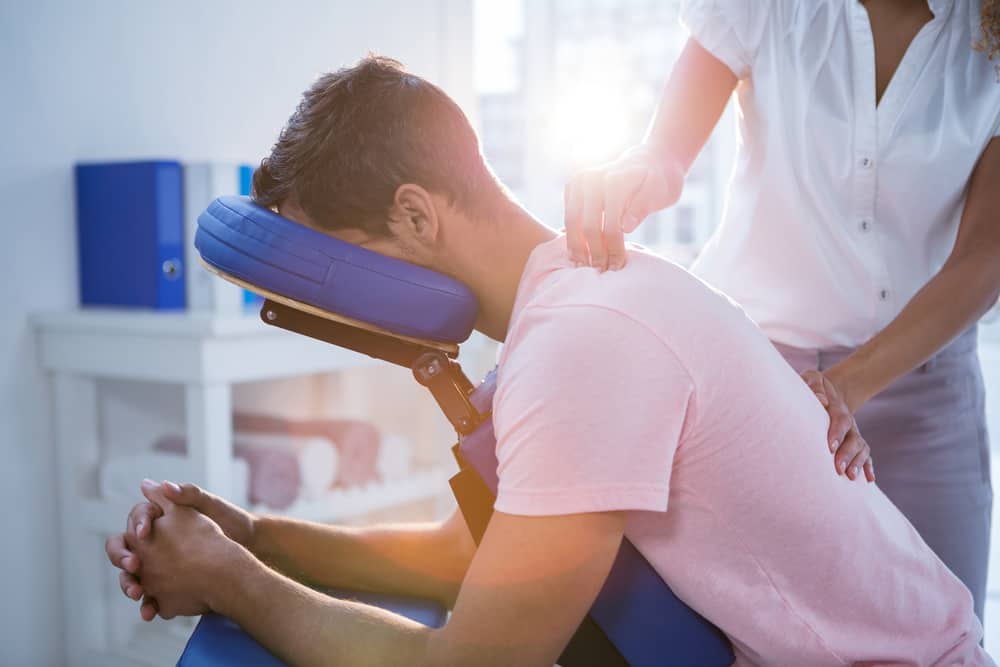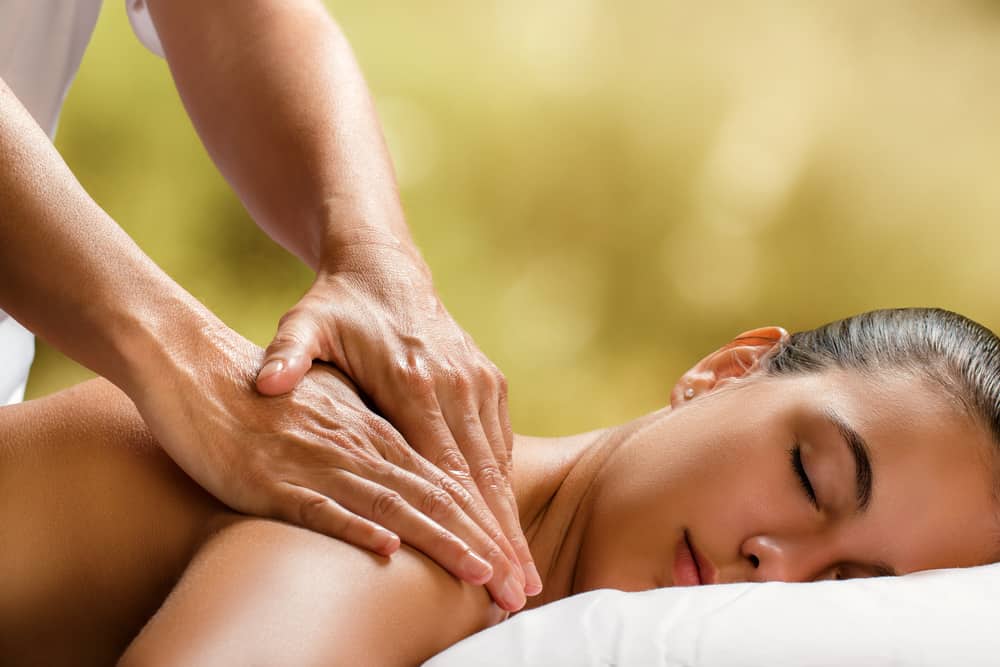Massage
If you’re looking to get fit or burn some calories but would rather pop into your serene spa than go to the gym, I get you! Wouldn’t we all prefer lying down and possibly falling asleep while all the hard work gets done for us?
Here’s the thing, while a massage is probably not going to replace exercise, you’re most likely to feel like you’ve had a workout session after a good massage. If the muscles are not used to it, they often respond with some level of soreness. Exercise and massage also share several physical, emotional, and mental benefits, and both allow the possibility of a few moans and groans.
A massage can feel much like a workout leaving your muscles sore and tired after, although this shouldn’t last more than a day or two. If it’s deep tissue or lymphatic drainage massage, you’re more likely to get an after-effect like this. The inflammation and inability to move fully can easily be achieved through massage. In terms of calorie burning, exercise breaks quite a sweat, but massage too can have a similar effect, all while lying down.
Does massage have the same effect as a workout?
You’re probably thinking, how? The 2 have nothing in common; one makes you sweat, and the other makes you want to fall asleep, so no way, right? Here’s the thing, the obvious differences are true, but they actually have more in common than you think.
Here are some examples:
- Frequency and consistency. Just as you need to exercise regularly to see and maintain results, the same goes with a massage to keep the pain away, muscles relaxed, and toxins flowing out.
- Lactic acid. While exercise releases lactic acid, which then causes those tension knots we feel, a massage can squeeze that build up out of the muscle fibers, creating muscle soreness and tenderness very similar to exercise.
- Water intake. Water is always needed after a workout session, but not many realize the importance of rehydrating after a massage, after allowing the flow of lymphatic fluids, which has detoxing benefits.
- Metabolism. Both exercise and massage can improve metabolism from improving digestion, but both require much more than that for weight loss example, healthy eating, lifestyle changes, etc.
- Hormones. Massage and exercise physically hurts and feels good at the same time. It also triggers a release of endorphins and other feel-good hormones like serotonin and dopamine, which encourage decreased anxiety.
- Trainer/Therapist. Just as you need to listen to your trainer’s advice or pre and post-exercise sessions plus lifestyle changes, the same goes with massage therapists. It’s important to take heed when they tell you to stretch, rest and drink water after a massage to gain full benefit from your sessions.
Basically, a massage is not an exercise, but it sure has many of the same benefits and can definitely burn calories. Both help with a limited range of motion and postural deviations. And both require a commitment to see long-lasting results.
Do massages burn calories?
You can bet it has some calorie-burning benefits. You’re most likely to feel like you’ve had a workout session after a good massage. An hour-long massage can actually burn more calories than you think. It’s almost like an hour of a lightweight training session and can burn up to 230-270 calories.
Massages improve digestion, and most of the time, when digestion is optimal, your body naturally functions better and can aid in weight loss. Lymphatic drainage and deep tissue massage can manually push waste out of the body’s tissue, leading to decreased water retention, inflammation, and overall weight.
An important note to remember is that no one should fully rely only on exercise or massage to get maximum weight loss results. It’s necessary to follow a clean, healthy, wholesome eating plan and make other lifestyle changes, e.g., reduce stress, sleep better, etc.
Would massage impact muscle growth and bodybuilding?
Yes. It most certainly will. Many people might find it emasculating for a bodybuilder to sit through a massage, yet it’s one of the best decisions to take because of the variety of benefits. Massage therapy improves your circulation and breathing, which allows faster healing after training and makes the soft tissue stronger and healthier. This helps with more effective training and decreased recovery time between sessions.
The improved blood flow decreases inflammation and helps with muscle growth, allowing an optimum workout regardless of whether you are a bodybuilder or someone just looking to tone and improve fitness and strength.
Injuries are common among bodybuilders who tend to lift heavy weights and increase sets. Massage therapy (especially sports massage) reduces damage to the muscles and returns a muscle to its normal working condition. This also means it can prevent reoccurring injuries, and regular massage will maintain muscle health.

How to gain maximum benefit from a massage?
Whether you are looking to massage for its unique benefits or exercise effects, these 10 tips should help:
- Be receptive and open to the massage and allow yourself to enjoy it.
- Do not eat or drink too much liquid right before a session.
- Be on time to ensure your massage is not cut short.
- Only take off as much clothing as you are comfortable with.
- Communicate your requirements with your therapist.
- Remember to breathe normally and consistently.
- Relax your mind and body.
- Drink extra water after a session.
- Take a few minutes to rest before getting up after the massage.
- Schedule regular massage sessions and stay consistent.
How often should you get a massage?
You might be surprised to know that you can actually get massaged too frequently. The most you should have one done is once a week unless you are dealing with pain or high-intensity sports. Your therapist will most likely ask you some questions to determine a good frequency based on your lifestyle, needs, and body’s response.
Deep tissue massages, especially if done alongside exercise, should be done once every two to three weeks, allowing the muscle tissue to heal and repair between sessions. Intense pain can often be felt if the body is really stiff or under high stress and giving proper resting time is crucial to avoid further damage, much like with exercise.
Most people tend to wait until illness occurs or weight and stiffness are out of control before starting an exercise regime, and in the same way, people tend to wait until they feel aches and pains before going for a massage. Both of these situations can be somewhat avoided if regularly kept up with. Prevention is better than cure.
Disadvantages of massages
While massages are generally quite safe, there are some negative aspects and side effects. Here are some examples listed below:
- Time-consuming. In our current busy hustling world, a massage can seem like its taking away from being productive.
- Expensive. Massage is considered a luxury treatment and can often be pricey depending on specifics, areas, salon rating, and therapist qualifications.
- Awkwardness. If you are someone who is shy, ticklish, or not a fan of physical contact, a massage can feel awkward and slightly uncomfortable.
- Muscle Pain. Many people can suffer some version of pain due to professional deep tissue techniques (ask for a light pressure relaxing technique if that’s what you prefer)
- Headaches. Not as common but can happen due to the position of the head during the session and more commonly from not drinking enough water after.
- Fatigue. Releasing tension generally allows the body and mind to enter relaxation mode, and also lying down for a fair amount of time are both factors causing fatigue and sleepiness.
- Skin sensitivity. Pressure and rubbing can cause redness which may lead to sensitivity. The feeling of heat can also be experienced due to muscles reacting.
- Nausea. This is mainly from releasing toxins. Water and rest can help to relieve these symptoms, and it’s not a very common effect.
- Aggravating an older injury. It’s important to work with a professional therapist and inform them of your past injuries to avoid this from happening. The cause of this is from pressure and stimulation methods.
Observe that each of these points is extremely common factors with exercise in some shape or form as well.
Conclusion
From all the above info it would be fair to say that they are both extremely beneficial in similar yet their own ways.
Exercise is recommended for a healthy lifestyle, fitness, strength, advanced weight loss, muscle building, and overall health. Massage therapy is recommended for healthy well-being, repairing, and relaxation. Even with their similar effects, one cannot replace the other since each one’s personal properties are unique.
Both exercise and massage therapy are very much each individual’s personal choice which stems from preference. It’s safe to agree that many people would prefer to do both and gain maximum benefits.
